Regional Ecological Security Pattern Construction Based on Ecological Barriers: A Case Study of the Bohai Bay Terrestrial Ecosystem
Abstract
1. Introduction
2. Materials and Methods
2.1. Study Area
2.2. Data Sources
2.3. Methods
2.3.1. Integrated Framework
2.3.2. Identifying Ecological Barriers
2.3.3. ESP Construction
3. Results
3.1. Habitat Quality in the Terrestrial Ecosystem of Bohai Bay
3.2. Habitat Risk Assessment
3.2.1. Overall Situation
3.2.2. Impact of Different Risk Sources on Ecological Sources
3.2.3. Ecological Barriers Identification
3.2.4. Ecological Security Patterns
4. Discussion
4.1. Using Ecological Risk Assessment for Ecological Source Zoning
4.2. Identification of Ecological Barrier Construction Areas
4.3. The Relationship between Ecological Barriers and Ecological Security Patterns
5. Conclusions
Author Contributions
Funding
Institutional Review Board Statement
Informed Consent Statement
Data Availability Statement
Conflicts of Interest
References
- MA (Millennium Ecosystem Assessment). Ecosystems and Human Well-Being: Synthesis; Island Press: Washington, DC, USA, 2005. [Google Scholar]
- Wang, Y.; Pan, J. Building ecological security patterns based on ecosystem services value reconstruction in an arid inland basin: A case study in Ganzhou District, NW China. J. Clean. Prod. 2019, 241, 118337. [Google Scholar] [CrossRef]
- Su, Y.; Chen, X.; Liao, J.; Zhang, H.; Wang, C.; Ye, Y.; Wang, Y. Modeling the optimal ecological security pattern for guiding the urban constructed land expansions. Urban For. Urban Green. 2016, 19, 35–46. [Google Scholar] [CrossRef]
- Opdam, P.; Steingröver, E.; Van Rooij, S. Ecological networks: A spatial concept for multi-actor planning of sustainable landscapes. Landsc. Urban Plan. 2006, 75, 322–332. [Google Scholar] [CrossRef]
- Yu, K. Security patterns and surface model in landscape ecological planning. Landsc. Urban Plan. 1996, 36, 1–17. [Google Scholar] [CrossRef]
- Wang, C.; Yu, C.; Chen, T.; Feng, Z.; Hu, Y.; Wu, K. Can the establishment of ecological security patterns improve ecological protection? An example of Nanchang, China. Sci. Total Environ. 2020, 740, 140051. [Google Scholar] [CrossRef]
- Peng, J.; Yang, Y.; Liu, Y.; Hu, Y.; Du, Y.; Meersmans, J.; Qiu, S. Linking ecosystem services and circuit theory to identify ecological security patterns. Sci. Total Environ. 2018, 644, 781–790. [Google Scholar] [CrossRef]
- Costanza, R.; de Groot, R.; Braat, L.; Kubiszewski, I.; Fioramonti, L.; Sutton, P.; Farber, S.; Grasso, M. Twenty years of ecosystem services: How far have we come and how far do we still need to go? Ecosyst. Serv. 2017, 28, 1–16. [Google Scholar] [CrossRef]
- Yuan, Y.; Bai, Z.; Zhang, J.; Xu, C. Increasing urban ecological resilience based on ecological security pattern: A case study in a resource-based city. Ecol. Eng. 2022, 175, 106486. [Google Scholar] [CrossRef]
- Lawton, J.H.J.C.U.P.; Daily, G.C. (Eds.) Nature’s Services: Societal Dependence on Natural Ecosystems; Island Press: Washington, DC, USA, 1997; p. 392. ISBN1 1-55963-475-8 (hbk). ISBN2 1-55963-476-6 (soft cover). 1998. [Google Scholar]
- Yang, Q.; Liu, G.; Casazza, M.; Hao, Y.; Giannetti, B.F. Emergy-based accounting method for aquatic ecosystem services valuation: A case of China. J. Clean. Prod. 2019, 230, 55–68. [Google Scholar] [CrossRef]
- Assumma, V.; Bottero, M.; Caprioli, C.; Datola, G.; Mondini, G. Evaluation of Ecosystem Services in Mining Basins: An Application in the Piedmont Region (Italy). Sustainability 2022, 14, 872. [Google Scholar] [CrossRef]
- Peng, J.; Pan, Y.; Liu, Y.; Zhao, H.; Wang, Y. Linking ecological degradation risk to identify ecological security patterns in a rapidly urbanizing landscape. Habitat Int. 2018, 71, 110–124. [Google Scholar] [CrossRef]
- Gong, J.; Cao, E.; Xie, Y.; Xu, C.; Li, H.; Yan, L. Integrating ecosystem services and landscape ecological risk into adaptive management: Insights from a western mountain-basin area, China. J. Environ. Manag. 2021, 281, 111817. [Google Scholar] [CrossRef] [PubMed]
- The Natural Capital, P. Habitat Risk Assessment. InVEST 3.6.0 Documentation. 2017. Available online: https://invest-userguide.readthedocs.io/en/latest/habitat_risk_assessment.html (accessed on 17 March 2022).
- Kheirkhah Ghehi, N.; MalekMohammadi, B.; Jafari, H. Integrating habitat risk assessment and connectivity analysis in ranking habitat patches for conservation in protected areas. J. Nat. Conserv. 2020, 56, 125867. [Google Scholar] [CrossRef]
- Caro, C.; Marques, J.C.; Cunha, P.P.; Teixeira, Z. Ecosystem services as a resilience descriptor in habitat risk assessment using the InVEST model. Ecol. Indic. 2020, 115, 106426. [Google Scholar] [CrossRef]
- Studwell, A.; Hines, E.; Nur, N.; Jahncke, J. Using habitat risk assessment to assess disturbance from maritime activities to inform seabird conservation in a coastal marine ecosystem. Ocean Coast. Manag. 2021, 199, 105431. [Google Scholar] [CrossRef]
- Arkema, K.K.; Verutes, G.; Bernhardt, J.R.; Clarke, C.; Rosado, S.; Canto, M.; Wood, S.A.; Ruckelshaus, M.; Rosenthal, A.; McField, M.; et al. Assessing habitat risk from human activities to inform coastal and marine spatial planning: A demonstration in Belize. Environ. Res. Lett. 2014, 9, 114016. [Google Scholar] [CrossRef]
- Samhouri, J.F.; Levin, P.S. Linking land- and sea-based activities to risk in coastal ecosystems. Biol. Conserv. 2012, 145, 118–129. [Google Scholar] [CrossRef]
- Zhai, T.; Wang, J.; Fang, Y.; Qin, Y.; Huang, L.; Chen, Y. Assessing ecological risks caused by human activities in rapid urbanization coastal areas: Towards an integrated approach to determining key areas of terrestrial-oceanic ecosystems preservation and restoration. Sci. Total Environ. 2020, 708, 135153. [Google Scholar] [CrossRef]
- Lin, Q.; Mao, J.; Wu, J.; Li, W.; Yang, J. Ecological Security Pattern Analysis Based on InVEST and Least-Cost Path Model: A Case Study of Dongguan Water Village. Sustainability 2016, 8, 172. [Google Scholar] [CrossRef]
- Hepcan, C.C.; Ozkan, M.B. Establishing ecological networks for habitat conservation in the case of Cesme-Urla Peninsula, Turkey. Environ. Monit. Assess. 2011, 174, 157–170. [Google Scholar] [CrossRef]
- Keeley, A.T.H.; Beier, P.; Gagnon, J.W. Estimating landscape resistance from habitat suitability: Effects of data source and nonlinearities. Landsc. Ecol. 2016, 31, 2151–2162. [Google Scholar] [CrossRef]
- Proctor, M.F.; Nielsen, S.E.; Kasworm, W.F.; Servheen, C.; Radandt, T.G.; Machutchon, A.G.; Boyce, M.S. Grizzly bear connectivity mapping in the Canada–United States trans-border region. J. Wildl. Manag. 2015, 79, 544–558. [Google Scholar] [CrossRef]
- McRae, B.H. Isolation by resistance. Evolution 2006, 60, 1551–1561. [Google Scholar] [CrossRef] [PubMed]
- Chetkiewicz, C.-L.B.; Clair, C.C.S.; Boyce, M.S. Corridors for Conservation: Integrating Pattern and Process. Annu. Rev. Ecol. Evol. Syst. 2006, 37, 317–342. [Google Scholar] [CrossRef]
- Wei, S.; Pan, J.; Liu, X. Landscape ecological safety assessment and landscape pattern optimization in arid inland river basin: Take Ganzhou District as an example. Hum. Ecol. Risk Assess. Int. J. 2018, 26, 782–806. [Google Scholar] [CrossRef]
- Yuanjing, Z.; Binyang, Y.; Ashraf, M.A. Ecological Security Pattern for the Landscape of Mesoscale and Microscale Land: A Case Study of the Harbin City Center. J. Environ. Eng. Landsc. Manag. 2015, 23, 192–201. [Google Scholar] [CrossRef][Green Version]
- Pan, K.; Wu, N.; Pan, K.; Chen, C. A discussion on the issues of there-construction of ecological shelter zone on the upper reaches of the Yangtze. Acta Ecol. Sin. 2004, 24, 617–629. (In Chinese) [Google Scholar]
- Yu, Z.; Qin, T.; Yan, D.; Yang, M.; Yu, H.; Shi, W. The Impact on the Ecosystem Services Value of the Ecological Shelter Zone Reconstruction in the Upper Reaches Basin of the Yangtze River in China. Int. J. Environ. Res. Public Health 2018, 15, 2273. [Google Scholar] [CrossRef]
- Yang, D. On the Construction of the Ecological Protective Screen for the Upper Reaches of the Changjiang River. J. Sichuan For. Sci. Technol. 2002, 23, 1–6. (In Chinese) [Google Scholar]
- Bao, Y.; Bao, Y.H.; Alarten, T.; Wu, L.T.Y. Construction and Protection of Inner Mongolian Ecological Screen. Res. Soil Water Conserv. 2002, 9, 62–65. (In Chinese) [Google Scholar]
- Chen, S.; Diao, C.; Zhou, C. Study on Reconstruction and Functional Regionalization of Ecological Shelter Zone in Land Use Planning-A Case Study of Yongchuan District, Chongqing City. Res. Soil Water Conserv. 2011, 1, 105–110. (In Chinese) [Google Scholar]
- Jiang, L.; Han, W.; Sun, L. A study on regional ecological barrier construction based on landscape ecological risk. Remote Sens. Land Resour. 2020, 32, 219–226. (In Chinese) [Google Scholar]
- Wang, X.; Huang, G.; Zhang, Y.; Cheng, Z.; Yang, Y. The Layout of its Ecological Protective Barrier in Ganzhou City based on Regional Carrying Capacity of Resources and Environments. J. Fujian For. Sci. Technol. 2014, 2, 161–165. (In Chinese) [Google Scholar] [CrossRef]
- Zhao, X.; Wang, Q.; Jin, F.; Luo, N.; Fan, B.; Li, X.; Qin, F.; Zhang, H. Re-exploration program for petroleum-rich sags and its significance in Bohai Bay Basin, East China. Pet. Explor. Dev. 2015, 42, 790–801. [Google Scholar] [CrossRef]
- Huang, L.; Tan, Y.; Song, X.; Huang, X.; Wang, H.; Zhang, S.; Dong, J.; Chen, R. The status of the ecological environment and a proposed protection strategy in Sanya Bay, Hainan Island, China. Mar. Pollut. Bull. 2003, 47, 180–186. [Google Scholar] [CrossRef]
- Yuan, Y.; Song, D.; Wu, W.; Liang, S.; Wang, Y.; Ren, Z. The impact of anthropogenic activities on marine environment in Jiaozhou Bay, Qingdao, China: A review and a case study. Reg. Stud. Mar. Sci. 2016, 8, 287–296. [Google Scholar] [CrossRef]
- Yu, L.; Hou, X.; Gao, M.; Shi, P. Assessment of coastal zone sustainable development: A case study of Yantai, China. Ecol. Indic. 2010, 10, 1218–1225. [Google Scholar] [CrossRef]
- Ma, T.; Li, X.; Bai, J.; Cui, B. Habitat modification in relation to coastal reclamation and its impacts on waterbirds along China’s coast. Glob. Ecol. Conserv. 2019, 17, e00585. [Google Scholar] [CrossRef]
- Zhang, L.; Peng, J.; Liu, Y.; Wu, J. Coupling ecosystem services supply and human ecological demand to identify landscape ecological security pattern: A case study in Beijing–Tianjin–Hebei region, China. Urban Ecosyst. 2016, 20, 701–714. [Google Scholar] [CrossRef]
- Grafius, D.R.; Corstanje, R.; Warren, P.H.; Evans, K.L.; Hancock, S.; Harris, J.A. The impact of land use/land cover scale on modelling urban ecosystem services. Landsc. Ecol. 2016, 31, 1509–1522. [Google Scholar] [CrossRef]
- Li, F.; Wang, L.; Chen, Z.; Clarke, K.C.; Li, M.; Jiang, P. Extending the SLEUTH model to integrate habitat quality into urban growth simulation. J. Environ. Manag. 2018, 217, 486–498. [Google Scholar] [CrossRef] [PubMed]
- Sun, X.; Jiang, Z.; Liu, F.; Zhang, D. Monitoring spatio-temporal dynamics of habitat quality in Nansihu Lake basin, eastern China, from 1980 to 2015. Ecol. Indic. 2019, 102, 716–723. [Google Scholar] [CrossRef]
- Duggan, J.M.; Eichelberger, B.A.; Ma, S.; Lawler, J.J.; Ziv, G. Informing management of rare species with an approach combining scenario modeling and spatially explicit risk assessment. Ecosyst. Health Sustain. 2017, 1, 1–18. [Google Scholar] [CrossRef]
- Wyatt, K.H.; Griffin, R.; Guerry, A.D.; Ruckelshaus, M.; Fogarty, M.; Arkema, K.K. Habitat risk assessment for regional ocean planning in the U.S. Northeast and Mid-Atlantic. PLoS ONE 2017, 12, e0188776. [Google Scholar] [CrossRef]
- Spear, S.F.; Balkenhol, N.; Fortin, M.J.; McRae, B.H.; Scribner, K. Use of resistance surfaces for landscape genetic studies: Considerations for parameterization and analysis. Mol. Ecol. 2010, 19, 3576–3591. [Google Scholar] [CrossRef]
- Pickett, S.T.A.; Cadenasso, M.L.; Rosi-Marshall, E.J.; Belt, K.T.; Groffman, P.M.; Grove, J.M.; Irwin, E.G.; Kaushal, S.S.; LaDeau, S.L.; Nilon, C.H.; et al. Dynamic heterogeneity: A framework to promote ecological integration and hypothesis generation in urban systems. Urban Ecosyst. 2016, 20, 1–14. [Google Scholar] [CrossRef]
- Gurrutxaga, M.; Rubio, L.; Saura, S. Key connectors in protected forest area networks and the impact of highways: A transnational case study from the Cantabrian Range to the Western Alps (SW Europe). Landsc. Urban Plan. 2011, 101, 310–320. [Google Scholar] [CrossRef]
- Kong, F.; Yin, H.; Nakagoshi, N.; Zong, Y. Urban green space network development for biodiversity conservation: Identification based on graph theory and gravity modeling. Landsc. Urban Plan. 2010, 95, 16–27. [Google Scholar] [CrossRef]
- Verboom, J.; Pouwels, R. Ecological functioning of ecological networks: A species perspective. In Ecological Networks and Greenways: Concept, Design, Implementation (Cambridge Studies in Landscape Ecology); Jongman, R., Pungetti, G., Eds.; Cambridge University Press: Cambridge, UK, 2004; pp. 56–72. [Google Scholar] [CrossRef]
- Wu, L.; Sun, C.; Fan, F. Estimating the Characteristic Spatiotemporal Variation in Habitat Quality Using the InVEST Model—A Case Study from Guangdong–Hong Kong–Macao Greater Bay Area. Remote Sens. 2021, 13, 1008. [Google Scholar] [CrossRef]
- Zhang, X.; Song, W.; Lang, Y.; Feng, X.; Yuan, Q.; Wang, J. Land use changes in the coastal zone of China’s Hebei Province and the corresponding impacts on habitat quality. Land Use Policy 2020, 99, 104957. [Google Scholar] [CrossRef]
- Sallustio, L.; De Toni, A.; Strollo, A.; Di Febbraro, M.; Gissi, E.; Casella, L.; Geneletti, D.; Munafo, M.; Vizzarri, M.; Marchetti, M. Assessing habitat quality in relation to the spatial distribution of protected areas in Italy. J. Environ. Manag. 2017, 201, 129–137. [Google Scholar] [CrossRef] [PubMed]
- Peng, J.; Zhao, S.; Dong, J.; Liu, Y.; Meersmans, J.; Li, H.; Wu, J. Applying ant colony algorithm to identify ecological security patterns in megacities. Environ. Model. Softw. 2019, 117, 214–222. [Google Scholar] [CrossRef]
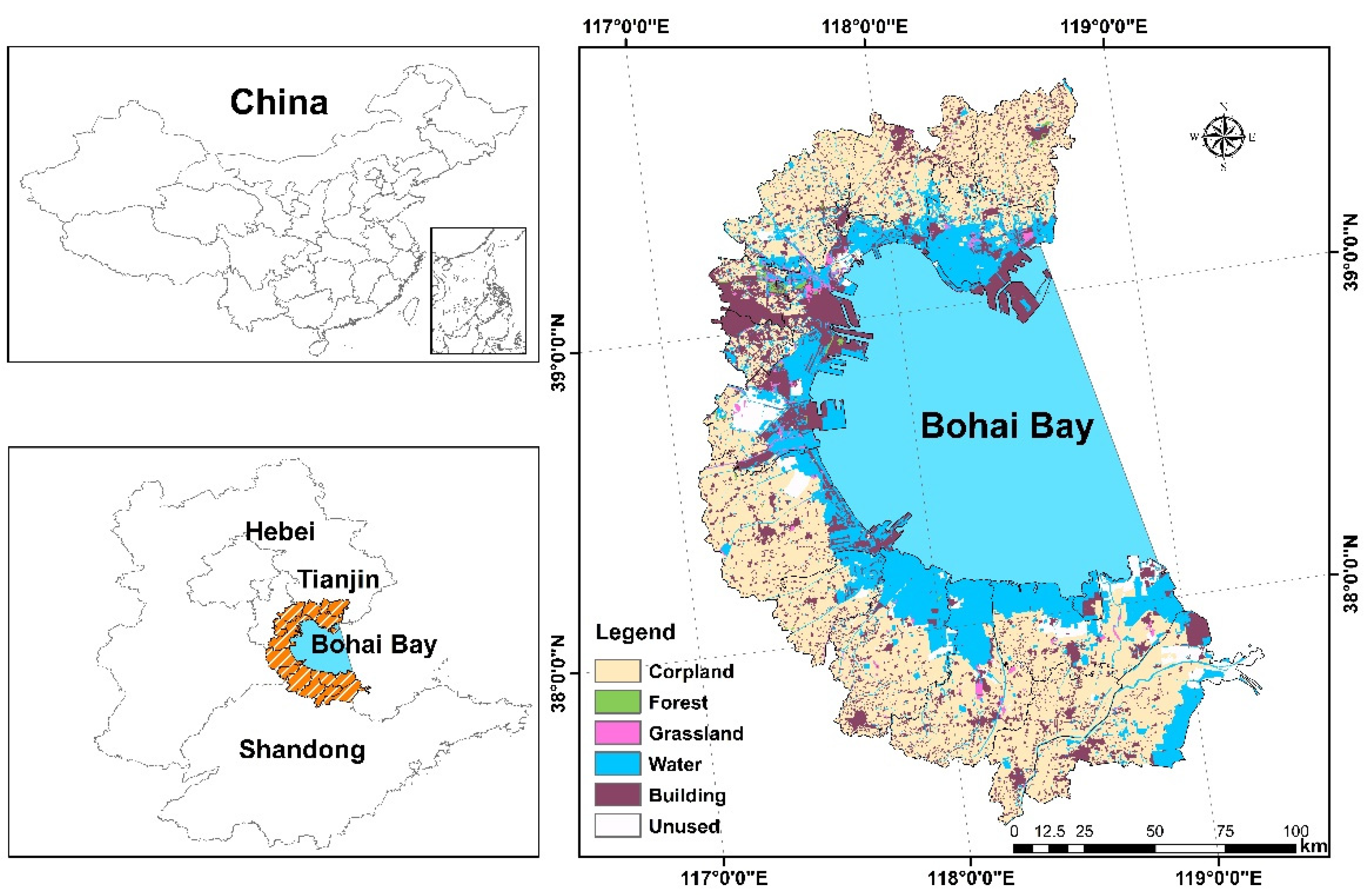
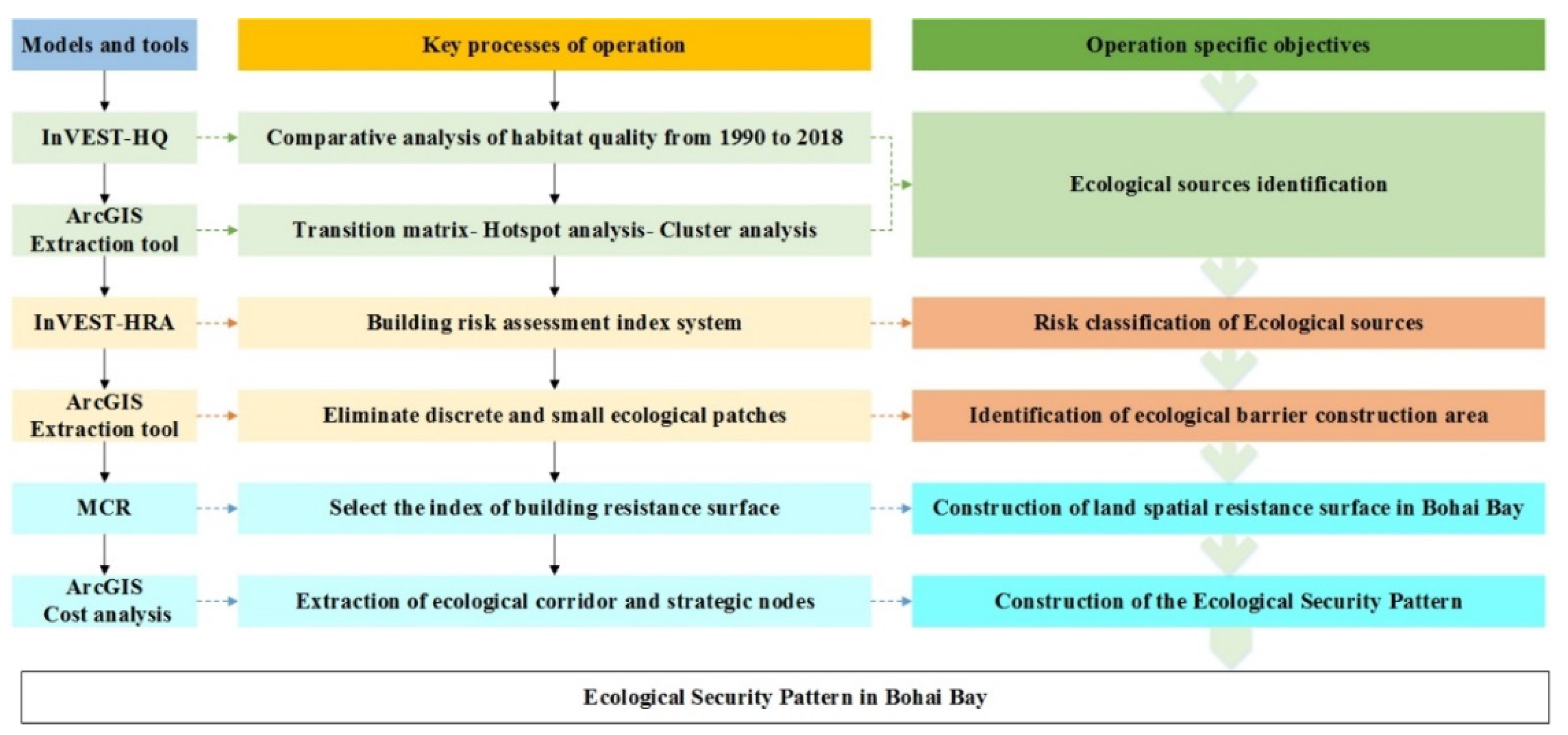
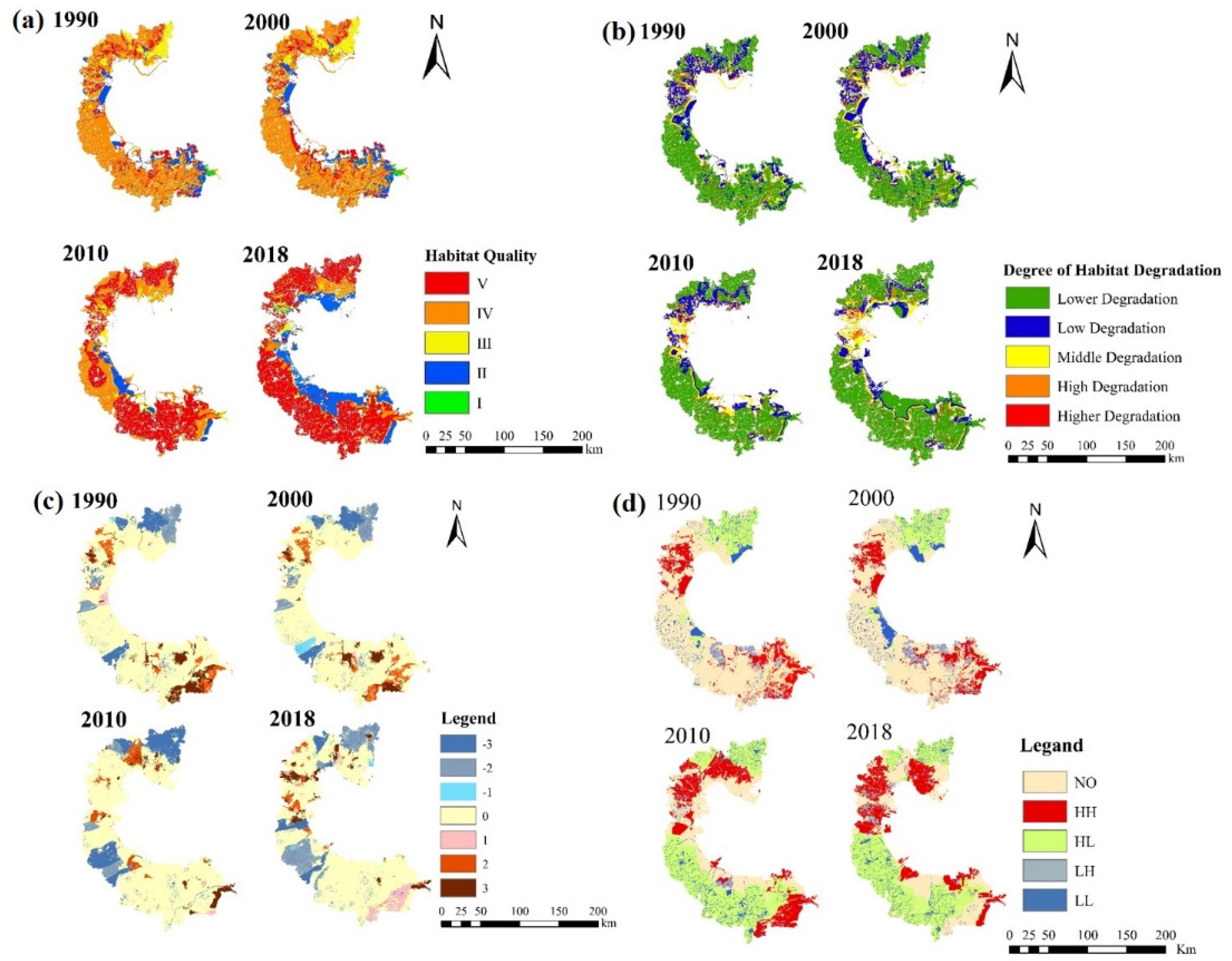

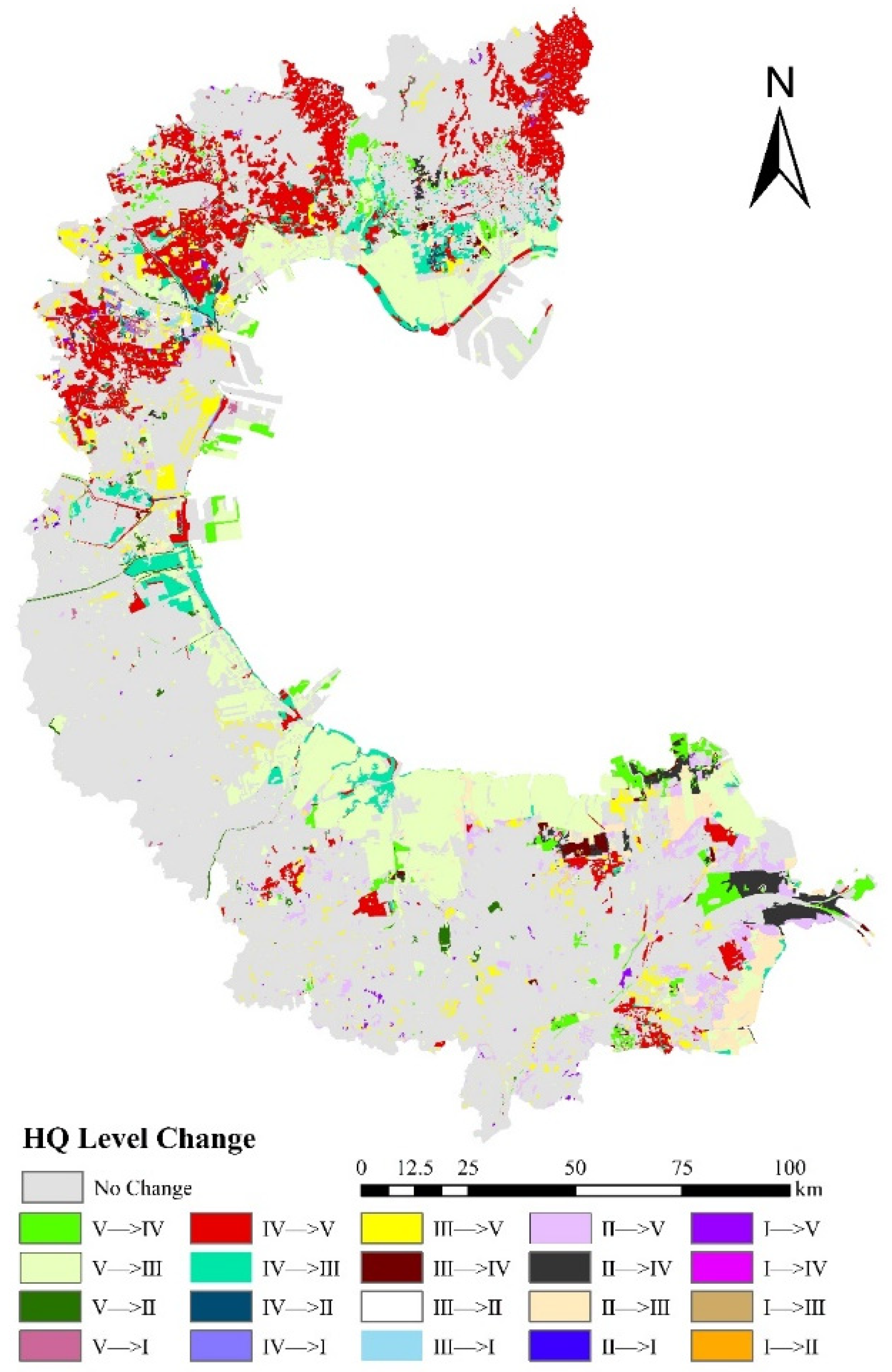
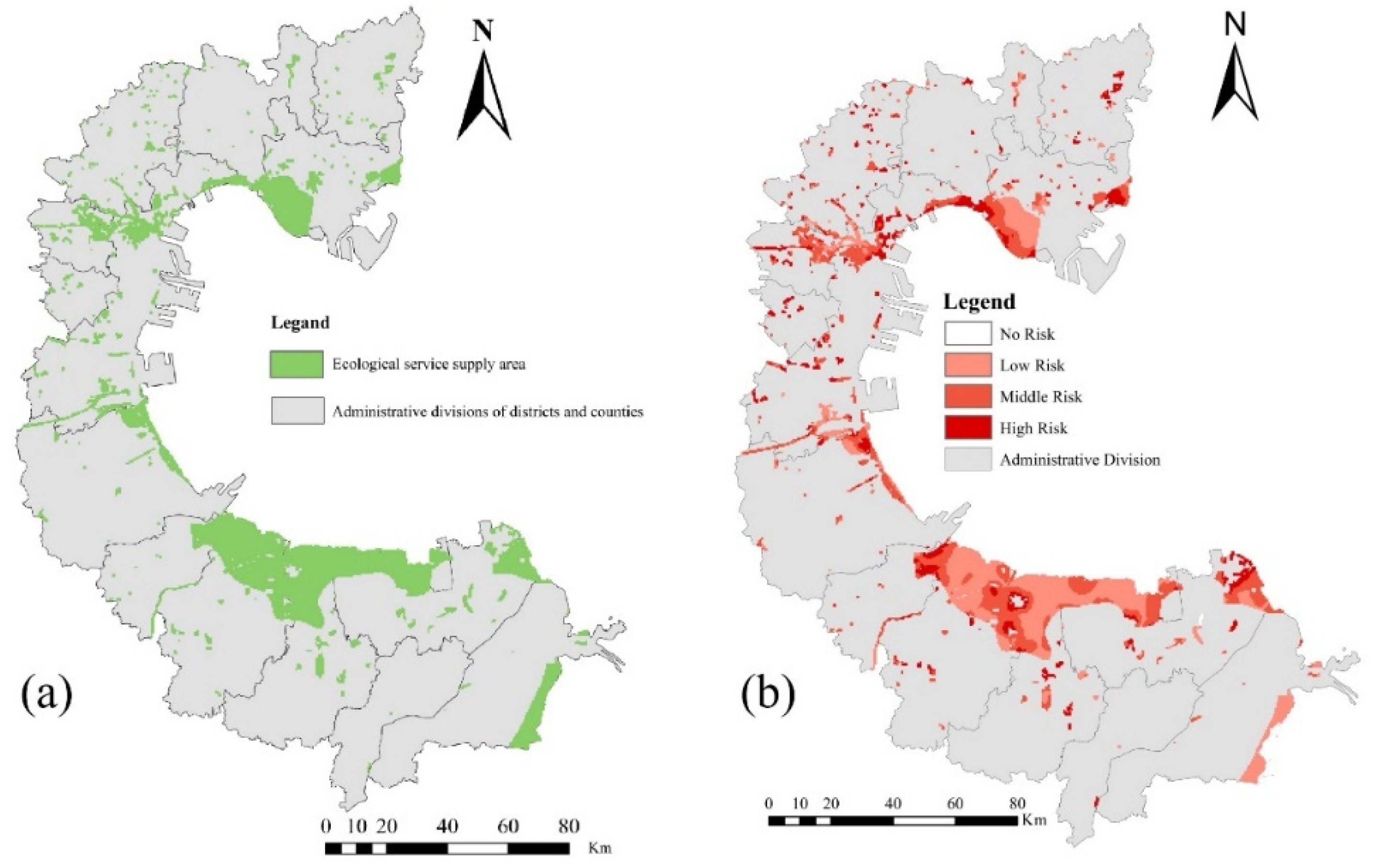
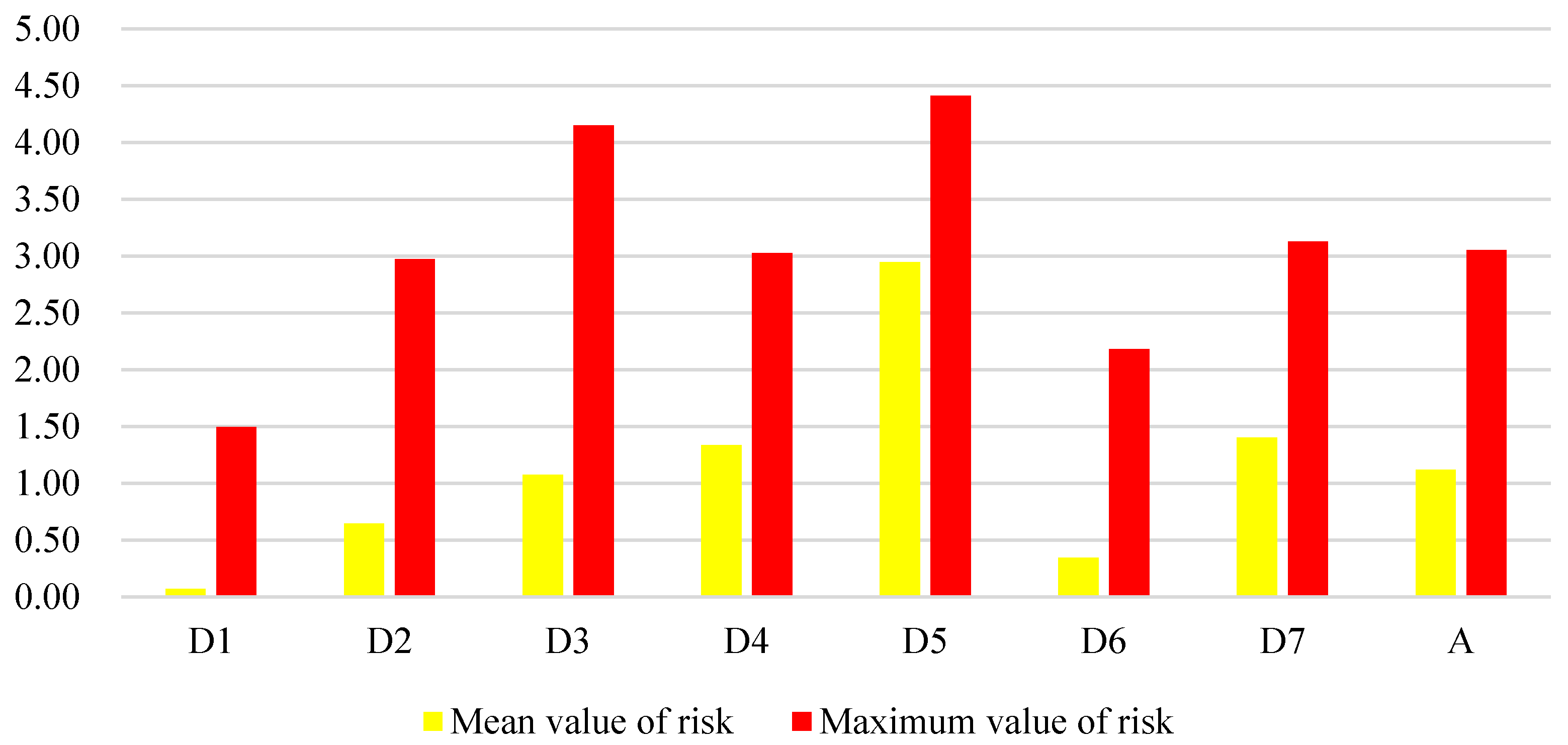


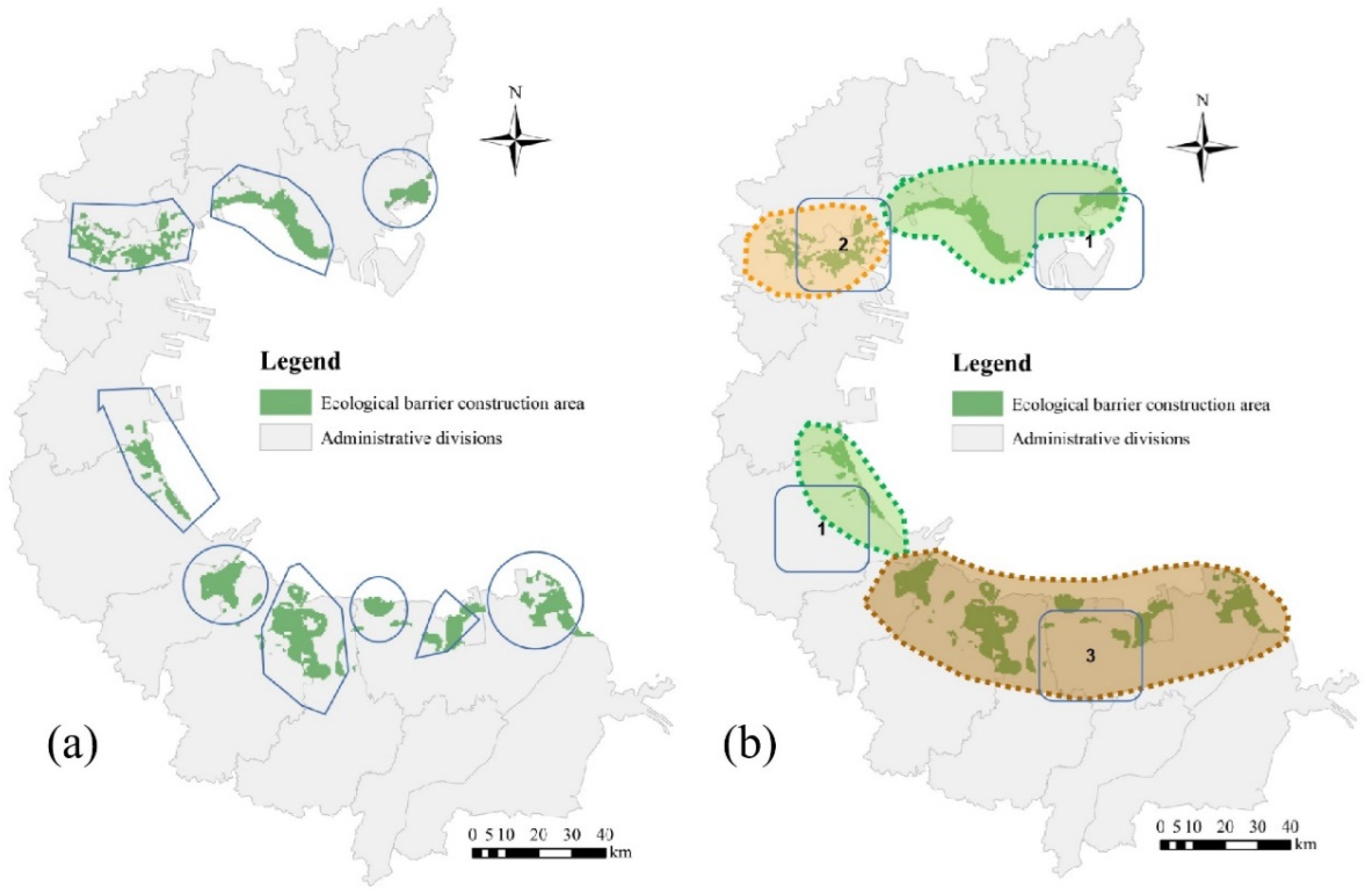


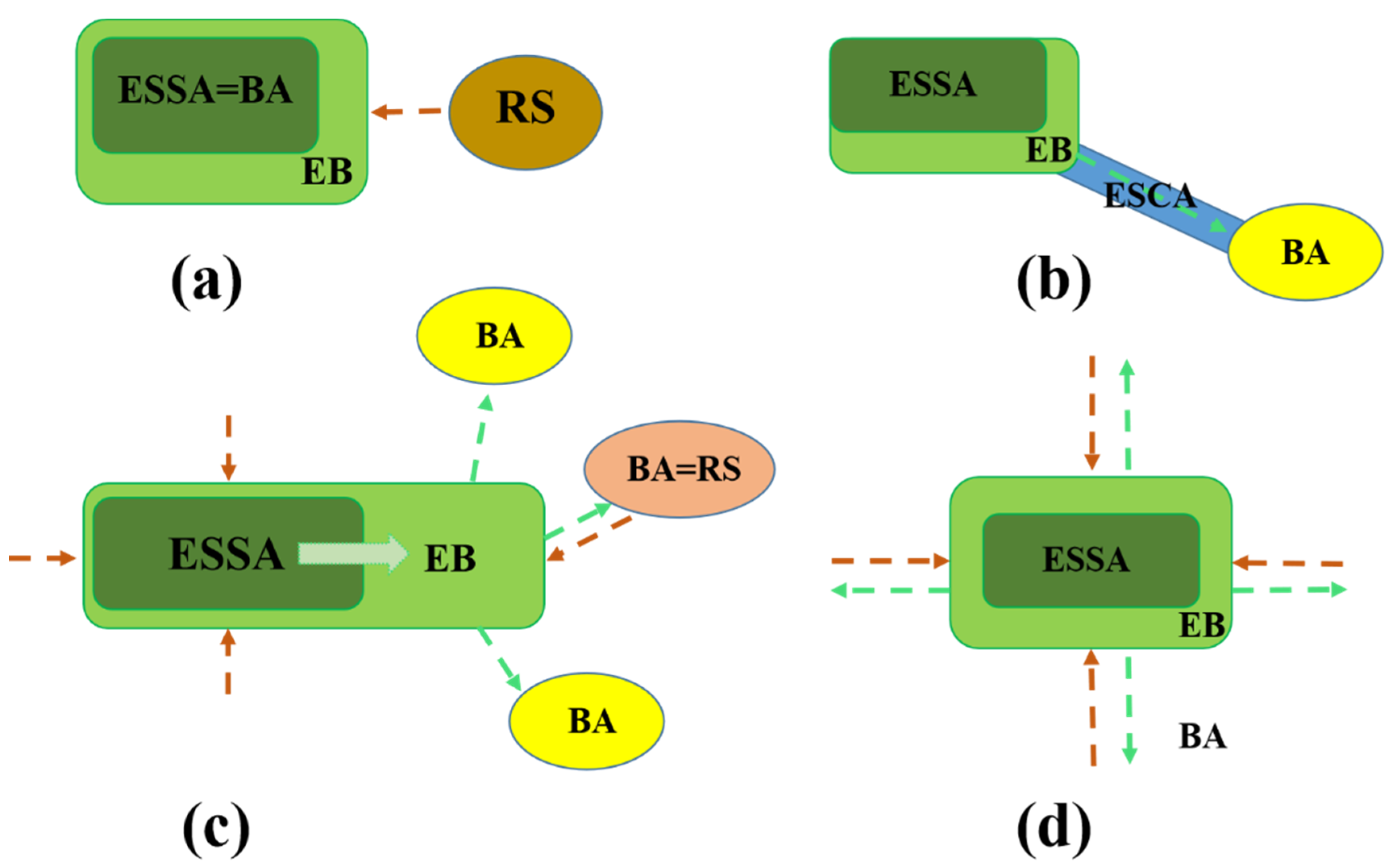

| Threat Source | Maximum Threat Distance (km) | Weights | Decay Form |
|---|---|---|---|
| Unused land | 4 | 0.3 | Exponential |
| Construction land | 6 | 1 | Exponential |
| Rural settlements | 5 | 0.6 | Exponential |
| Urban land | 9 | 1 | Exponential |
| Paddy fields | 6 | 0.5 | Linear |
| Drylands | 6 | 0.7 | Linear |
| Land Use Type | Habitat Suitability | Unused Land | Industrial and Construction Land | Rural Settlements | Urban Land | Paddy Fields | Drylands |
|---|---|---|---|---|---|---|---|
| Paddy fields | 0.6 | 0.1 | 0.2 | 0.35 | 0.5 | 0 | 0.3 |
| Drylands | 0.4 | 0.1 | 0.2 | 0.35 | 0.5 | 0.3 | 0 |
| Forests | 1 | 0.3 | 0.6 | 0.85 | 1 | 0.8 | 0.5 |
| Shrubs | 1 | 0.2 | 0.2 | 0.45 | 0.6 | 0.8 | 0.5 |
| Sparse woodlands | 1 | 0.3 | 0.65 | 0.9 | 1 | 0.8 | 0.55 |
| Other woodlands | 1 | 0.3 | 0.7 | 0.95 | 1 | 0.8 | 0.9 |
| High-coverage grasslands | 0.8 | 0.2 | 0.2 | 0.5 | 0.6 | 0.4 | 0.4 |
| Medium-coverage grasslands | 0.75 | 0.25 | 0.25 | 0.45 | 0.6 | 0.45 | 0.45 |
| Low-coverage grasslands | 0.7 | 0.3 | 0.3 | 0.6 | 0.7 | 0.5 | 0.5 |
| Canals | 0.3 | 0.3 | 0.3 | 0.3 | 0.5 | 0.3 | 0.3 |
| Lakes | 0.9 | 0.3 | 0.6 | 0.75 | 0.9 | 0.7 | 0.7 |
| Reservoirs | 0.7 | 0.3 | 0.5 | 0.75 | 0.9 | 0.7 | 0.7 |
| Beaches | 0.6 | 0.3 | 0.5 | 0.75 | 0.95 | 0.7 | 0.6 |
| Beachland | 0.6 | 0.5 | 0.55 | 0.85 | 0.95 | 0.75 | 0.75 |
| Cities | 0 | 0 | 0 | 0 | 0 | 0 | 0 |
| Rural settlements | 0 | 0 | 0 | 0 | 0 | 0 | 0 |
| Construction land | 0 | 0 | 0 | 0 | 0 | 0 | 0 |
| Sandy | 0.1 | 0.1 | 0.1 | 0.1 | 0.1 | 0.1 | 0.1 |
| Saline land | 0.2 | 0.1 | 0.1 | 0.1 | 0.1 | 0.1 | 0.1 |
| Swamps | 0.5 | 0.5 | 0.5 | 0.6 | 0.7 | 0.2 | 0.2 |
| Bare ground | 0 | 0 | 0 | 0 | 0 | 0 | 0 |
| Bare rocks | 0 | 0 | 0 | 0 | 0 | 0 | 0 |
| Other | 0 | 0 | 0 | 0 | 0 | 0 | 0 |
| Indicator Properties | Indicators | Risk Level | ||
|---|---|---|---|---|
| Low Risk | Medium Risk | High Risk | ||
| Exposure | Spatial overlay | Area of overlap between risk source and habitat < 10% | 10% ≤ Area of overlap between risk source and habitat < 30% | Area of overlap between risk source and habitat ≥ 30% |
| Disturbance frequency | The source of the threat is bare ground | The source of the threat is paddy fields and drylands | The sources of threat are reclamation activities, construction sites, and rural settlements | |
| Disturbance intensity | The source of the threat is bare ground | The sources of threat are rural settlements, paddy fields, and drylands | The sources of threat are enclosed areas, towns, and building sites | |
| Consequence | Habitat heterogeneity | Areas with a high habitat quality rating | Areas with a medium habitat quality rating | Areas with a low habitat quality rating |
| Management effectiveness | Habitat range is national, provincial, and municipal nature reserves | The habitat range is a tourist attraction | Habitat range not a nature reserve, tourist attraction | |
| Habitat vulnerability | The habitat area falls within the ecological red zone | Habitat area is a nature reserve | Habitat is neither an ecological red line nor a nature reserve | |
| Land Use Types | Resistance Coefficient |
|---|---|
| Forest | 1 |
| Grassland | 2 |
| Cropland | 30 |
| Water | 50 |
| Utilized land | 300 |
| Built-up land | 500 |
| HQ | Values | Area (km2) | Area Change Rate (%) | ||||||
|---|---|---|---|---|---|---|---|---|---|
| - | - | 1990 | 2000 | 2010 | 2018 | 1990–2000 | 2000–2010 | 2010–2018 | 1990–2018 |
| V | 0–0.4 | 2386.59 | 2564.62 | 7822.63 | 10,340.65 | 7.46 | 205.02 | 32.19 | 333.28 |
| IV | 0.4–0.6 | 10,064.96 | 9329.35 | 4851.87 | 1702.44 | −7.31 | −47.99 | −64.91 | −83.09 |
| III | 0.6–0.7 | 1599.97 | 1858.39 | 1090.77 | 1057.6 | 16.15 | −41.31 | −3.04 | −33.90 |
| II | 0.7–0.8 | 1607.19 | 1648.96 | 945.91 | 3276.68 | 2.60 | −42.64 | 246.41 | 103.88 |
| I | 0.8–1 | 204.05 | 211.84 | 22.38 | 88.8 | 3.82 | −89.44 | 296.78 | −56.48 |
| Year | Spatial Autocorrelation Analysis of Habitat Quality | ||
|---|---|---|---|
| Moran’s I | Z-Score | p-Value | |
| 1990 | 0.0816 | 69.7453 | 0.0000 |
| 2000 | 0.07968 | 71.2873 | 0.0000 |
| 2010 | 0.1238 | 78.9206 | 0.0000 |
| 2018 | 0.1663 | 93.7360 | 0.0000 |
Publisher’s Note: MDPI stays neutral with regard to jurisdictional claims in published maps and institutional affiliations. |
© 2022 by the authors. Licensee MDPI, Basel, Switzerland. This article is an open access article distributed under the terms and conditions of the Creative Commons Attribution (CC BY) license (https://creativecommons.org/licenses/by/4.0/).
Share and Cite
Zhang, J.; Cao, Y.; Ding, F.; Wu, J.; Chang, I.-S. Regional Ecological Security Pattern Construction Based on Ecological Barriers: A Case Study of the Bohai Bay Terrestrial Ecosystem. Sustainability 2022, 14, 5384. https://doi.org/10.3390/su14095384
Zhang J, Cao Y, Ding F, Wu J, Chang I-S. Regional Ecological Security Pattern Construction Based on Ecological Barriers: A Case Study of the Bohai Bay Terrestrial Ecosystem. Sustainability. 2022; 14(9):5384. https://doi.org/10.3390/su14095384
Chicago/Turabian StyleZhang, Jinxin, Yunmeng Cao, Fanshu Ding, Jing Wu, and I-Shin Chang. 2022. "Regional Ecological Security Pattern Construction Based on Ecological Barriers: A Case Study of the Bohai Bay Terrestrial Ecosystem" Sustainability 14, no. 9: 5384. https://doi.org/10.3390/su14095384
APA StyleZhang, J., Cao, Y., Ding, F., Wu, J., & Chang, I.-S. (2022). Regional Ecological Security Pattern Construction Based on Ecological Barriers: A Case Study of the Bohai Bay Terrestrial Ecosystem. Sustainability, 14(9), 5384. https://doi.org/10.3390/su14095384







